

William Smith (1769-1839) : Feature Articles. Fossils don’t just allow scientists to date rock layers, but also to uncover past climates, some of which differ dramatically from today’s.
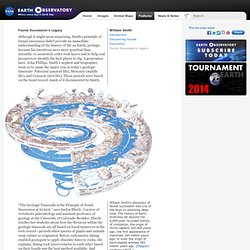
One of the best examples is the Eocene Epoch, roughly 55 to 34 million years ago. Although the continents were mostly in the same position then that they are today, Eberle has dug Eocene fossils in the Arctic and found a surprising collection of warm-weather fauna. “We’ve found fossils of alligators, turtles, tapirs, even primates,” she says. Fossil plants also left evidence of a warmer climate.
Eocene coal seams—compressed, old swamps—are abundant in the Arctic, as are ancient tree trunks and leaf impressions. Fossil succession has helped scientists to understand that not only has Earth’s climate changed throughout history, the ground itself has shifted across the planet’s surface. Rock Dating - Utah Geological Survey. How Do Geologists Know How Old a Rock Is?

By Mark Milligan Geologists generally know the age of a rock by determining the age of the group of rocks, or formation, that it is found in. The age of formations is marked on a geologic calendar known as the geologic time scale. Development of the geologic time scale and dating of formations and rocks relies upon two fundamentally different ways of telling time: relative and absolute. Relative dating places events or rocks in their chronologic sequence or order of occurrence. Geology and Geophysics.
Geologic time and the age of the Earth. The Age of the Universe. Daniel Perley Table of Contents Introduction One of the simplest, and most scientifically important, questions one can ask is the age of the universe we inhabit.
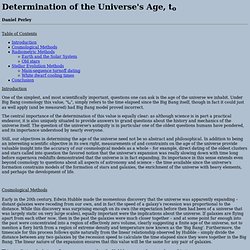
Under Big Bang cosmology this value, "to", simply refers to the time elapsed since the Big Bang itself, though in fact it could just as well apply (and be measured) had Big Bang model proved incorrect. Geologic Time: Age of the Earth. So far scientists have not found a way to determine the exact age of the Earth directly from Earth rocks because Earth's oldest rocks have been recycled and destroyed by the process of plate tectonics.
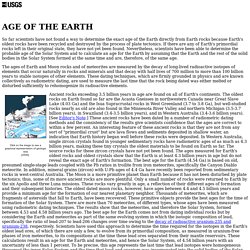
If there are any of Earth's primordial rocks left in their original state, they have not yet been found. WMAP News: Quick Facts. WMAP is collecting high-quality science data in its L2 orbit.
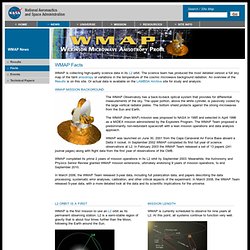
The world's oldest fossils: Researchers claim bacteria existed on Earth before OXYGEN. The fossils found in north-west Australia are thought to be 3.5bn years oldNot actual petrified remains, they are rather traces of organic processesResearchers claim the discovery could help the search for life on Mars By Damien Gayle Published: 16:42 GMT, 3 January 2013 | Updated: 16:42 GMT, 3 January 2013 Fossils of bacteria found in Australia are the oldest yet discovered anywhere on Earth and predate the formation of oxygen on our planet, new research claims.
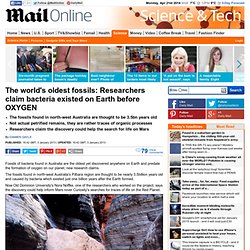
The fossils found in north-west Australia's Pilbara region are thought to be nearly 3.5billion years old and caused by bacteria which existed just one billion years after the Earth formed. Radiometric Dating. K-Ar Dating 40K is the radioactive isotope of K, and makes up 0.119% of natural K.

CMG InfoBank: Relative Age Dating of Rocks. Permian extinction : Alteration of the carbon cycle. Alteration of the carbon cycle The ratio between the stable isotopes of carbon (12C/13C) seems to indicate that significant changes in the carbon cycle took place starting about 500,000 to 1,000,000 years before the end of the Permian Period and crossing the boundary into the Induan Age (the first age of the Triassic Period).

These changes appear to coincide closely with two Permian extinction events, suggesting some cause-and-effect relationship with changes in the carbon cycle. Several studies have suggested that changes in the carbon isotope record may indicate a disrupted biological cycle. Britannica Online Encyclopedia. Stromatolites.
Paleophysiology and End-Permian Mass Extinction. The KT extinction. Tracking the Course of Evolution by Richard Cowen NOTE: This is page 1 of a three-page document.

THIS ESSAY, written in 1999, is a chapter from my book History of Life, published by Blackwell Science, Boston, Massachusetts, 2000. © Richard Cowen. You may print out a copy for personal or educational use, and you may link to this site. Calibrating the End-Permian Mass Extinction. WMAP- Age of the Universe.
Until recently, astronomers estimated that the Big Bang occurred between 12 and 14 billion years ago.
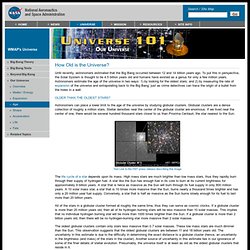
To put this in perspective, the Solar System is thought to be 4.5 billion years old and humans have existed as a genus for only a few million years. Astronomers estimate the age of the universe in two ways: 1) by looking for the oldest stars; and 2) by measuring the rate of expansion of the universe and extrapolating back to the Big Bang; just as crime detectives can trace the origin of a bullet from the holes in a wall. Older Than the Oldest Stars? Astronomers can place a lower limit to the age of the universe by studying globular clusters. Globular clusters are a dense collection of roughly a million stars.
Text Link to the HST press release describing this image. Www.geology.wisc.edu/courses/g101/Lectures/lec16_Geologic_Time_2.pdf. Www.physics.byu.edu/faculty/ireland/images/unit4/ps100ch26webnew.pdf. End-Permian Mass Extinction in the Oceans: An Ancient Analog for the Twenty-First Century? - Annual Review of Earth and Planetary Sciences, 40(1):89. Taxonomic composition and environmental distribution of post-extinction rhynchonelliform brachiopod faunas: Constraints on short-term survival and the role of anoxia in the end-Permian mass extinction Matthew E. Clapham, Margaret L. Fraiser, Pedro J. Marenco, and Shu-zhong Shen Palaeogeography, Palaeoclimatology, Palaeoecology Vol. 374 (2013) : 284-292. Mail.colonial.net/~rpavlik/pavlikweb/pdf/handouts/geologic/The_Rules_for_Relative_Dating.pdf.